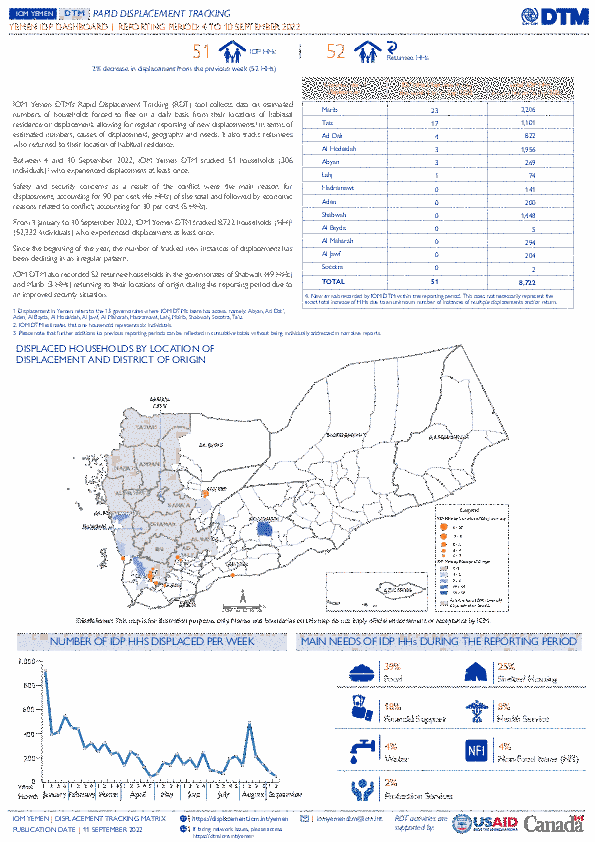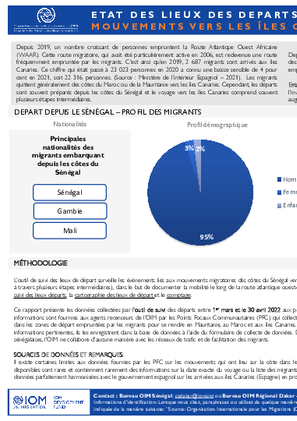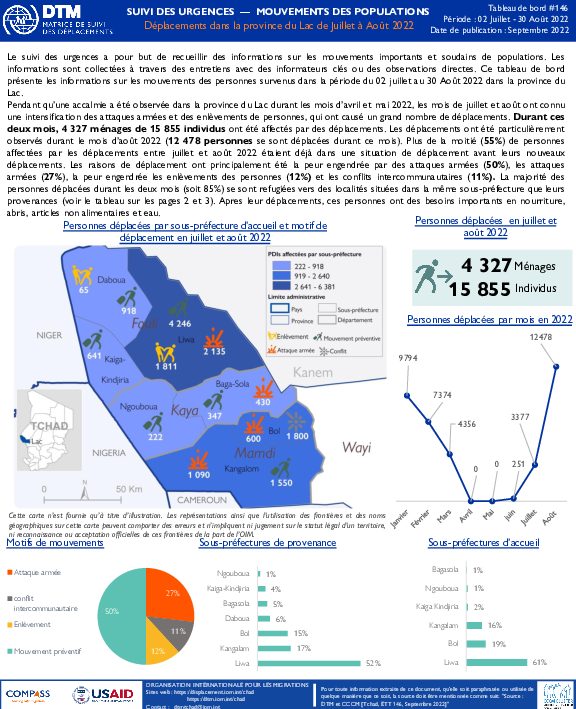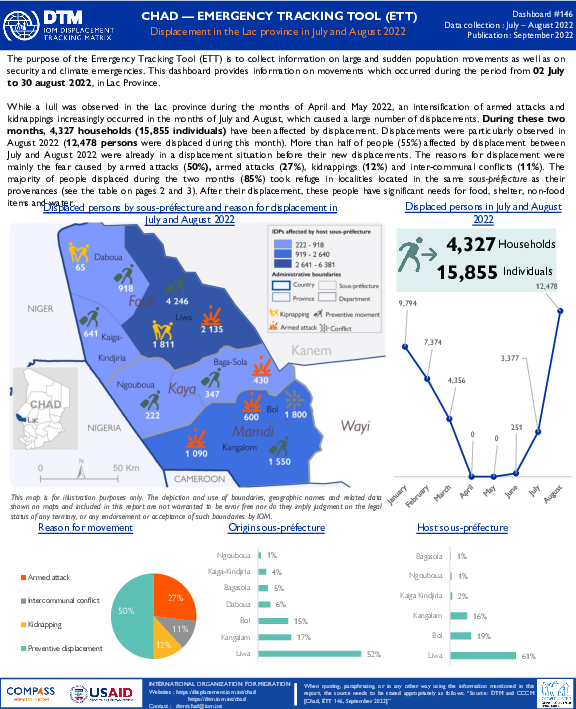-
Countries
-
Data and Analysis
-
Special Focus
-
Crisis Responses
This document is a compilation of data collected by IOM from Frontex as well as the Italian, Spanish, Greek and Maltese interior ministries on migratory movements from Africa to Europe between 2017 and 2022. IOM works closely with a wide range of actors, including government and non government partners, to collect and compile this data on a quarterly basis This document presents the situation of migrant arrivals in Europe based on data for 2021 from the point of view of movements from West and Central Africa.

Contact
DTM Yemen, iomyemendtm@iom.int
Language
English
Location
Yemen
Period Covered
Sep 04 2022
Sep 10 2022
Activity
- Mobility Tracking
IOM Yemen DTM’s Rapid Displacement Tracking (RDT) tool collects data on estimated numbers of households forced to flee on a daily basis from their locations of origin or displacement, allowing for regular reporting of new displacements in terms of estimated numbers, geography, and needs. It also tracks returnees who returned to their location of origin.
From 1 January to 10 September 2022, IOM Yemen DTM tracked 8,722 households (HH) (52,332 Individuals) who experienced displacement at least once.
Between 4 and 10 September 2022, IOM Yemen DTM tracked 51 households (306 individuals) displaced at least once. The majority of people moved into/within the following governorates and districts:
- Marib (23 HHs) – Marib City (22 HHs), Marib (1 HHs) districts. Most displacements in the governorate originated from Shabwah and Al Hodeidah.
- Taiz (17 HHs) – Al Maafer (10 HHs), Ash Shamayatayn (4 HHs), Al Mudhaffar (2 HHs) districts. Most displacements in the governorate originated from Taiz and Al Hodeidah.
- Ad Dali (4 HHs) – Qatabah (3 HHs), Ad Dali (1 HHs) districts. Most displacements in the governorate originated from Ad Dali and Al Hodeidah.
The majority of people moved from the following governorates and districts:
- Al Hodeidah (14 HHs) – Al Marawiah (8 HHs), At Tuhayta (4 HHs), Hays (1 HH) districts.
- Taiz (13 HHs) – Maqbanah (7 HHs), At Taiziyah (1 HHs), Hayfan (1 HH) districts.
- Shabwah (11 HHs) – Ataq (10 HHs), Bayhan (1 HH) districts.

Contact
RO Dakar, RODakar-DataResearch@iom.int
Language
French
Location
Senegal
Period Covered
May 01 2022
Jun 30 2022
Activity
- Other
- Flow Monitoring
L'Outil de suivi des zones de départ surveille les événements liés aux mouvements migratoires des côtes du Sénégal vers les îles Canaries espagnols (qui, le plus souvent, se déroulent à travers plusieurs étapes intermédiaires), dans le but de documenter la mobilité le long de la route atlantique ouest-africaine (WAAR). Ce rapport présente les données collectées par l'outil de suivi des départs entre le 1er mai et le 30 juin 2022 aux principaux points de départ le long du littoral sénégalais. Les informations sont fournies aux agents recenseurs par les Points Focaux Communautaires (PFC) qui fournissent des informations sur les événements notables observés dans les zones de départ utilisées par les migrants pour se rendre en Mauritanie, au Maroc et aux îles Canaries.

Contact
RO Dakar, RODakar-DataResearch@iom.int
Language
French
Location
Senegal
Period Covered
Mar 01 2022
Apr 30 2022
Activity
- Other
- Flow Monitoring
L'Outil de suivi des zones de départ surveille les événements liés aux mouvements migratoires des côtes du Sénégal vers les îles Canaries espagnols (qui, le plus souvent, se déroulent à travers plusieurs étapes intermédiaires), dans le but de documenter la mobilité le long de la route atlantique ouest-africaine (WAAR). Ce rapport présente les données collectées par l'outil de suivi des départs entre le 1er mars et le 30 avril 2022 aux principaux points de départ le long du littoral sénégalais. Les informations sont fournies aux agents recenseurs par les Points Focaux Communautaires (PFC) qui fournissent des informations sur les événements notables observés dans les zones de départ utilisées par les migrants pour se rendre en Mauritanie, au Maroc et aux îles Canaries.
Contact
DTM Haiti, DTMHaiti@iom.int
Location
Haiti
Activity
- Mobility Tracking
- Baseline Assessment
Period Covered
Apr 01 2022 -Sep 01 2022
A baseline assessment is a sub-component of mobility tracking. It aims to collect data on IDP, migrant or returnee population presence in a defined administrative area of the country.
Population Groups
Survey Methodology
Unit of Analysis Or Observation
Type of Survey or Assessment
Keywords
Geographical Scope
Administrative boundaries with available data
The current dataset covers the following administrative boundaries
Contact
Location
Yemen
Activity
- Mobility Tracking
Period Covered
Sep 04 2022 -Sep 10 2022
From 1 January to 10 September 2022, IOM Yemen DTM tracked 8,722 households (HH) (52,332 Individuals) who experienced displacement at least once.
Between 4 and 10 September 2022, IOM Yemen DTM tracked 51 households (306 individuals) displaced at least once. The majority of people moved into/within the following governorates and districts:
- Marib (23 HHs) – Marib City (22 HHs), Marib (1 HHs) districts. Most displacements in the governorate originated from Shabwah and Al Hodeidah.
- Taiz (17 HHs) – Al Maafer (10 HHs), Ash Shamayatayn (4 HHs), Al Mudhaffar (2 HHs) districts. Most displacements in the governorate originated from Taiz and Al Hodeidah.
- Ad Dali (4 HHs) – Qatabah (3 HHs), Ad Dali (1 HHs) districts. Most displacements in the governorate originated from Ad Dali and Al Hodeidah.
- Al Hodeidah (14 HHs) – Al Marawiah (8 HHs), At Tuhayta (4 HHs), Hays (1 HH) districts.
- Taiz (13 HHs) – Maqbanah (7 HHs), At Taiziyah (1 HHs), Hayfan (1 HH) districts.
- Shabwah (11 HHs) – Ataq (10 HHs), Bayhan (1 HH) districts.
Population Groups
Survey Methodology
Unit of Analysis Or Observation
Type of Survey or Assessment
Keywords
Geographical Scope
Administrative boundaries with available data
The current dataset covers the following administrative boundaries
Sep 10 2022
Print
Countries in this response
- Active DTM operation
- Past DTM operation

Contact
DTM Tchad, dtmtchad@iom.int
Language
French
Location
Chad
Period Covered
Jul 02 2022
Aug 30 2022
Activity
- Mobility Tracking
- Event Tracking
Le suivi des urgences a pour but de recueillir des informations sur les mouvements importants et soudains de populations. Les informations sont collectées à travers des entretiens avec des informateurs clés ou des observations directes. Ce tableau de bord présente les informations sur les mouvements des personnes survenus dans la période du 02 juillet au 30 Août 2022 dans la province du Lac.
Pendant qu’une accalmie a été observée dans la province du Lac durant les mois d’avril et mai 2022, les mois de juillet et août ont connu une intensification des attaques armées et des enlèvements de personnes, qui ont causé un grand nombre de déplacements. Durant ces deux mois, 4 327 ménages de 15 855 individus ont été affectés par des déplacements. Les déplacements ont été particulièrement observés durant le mois d’août 2022 (12 478 personnes se sont déplacées durant ce mois). Plus de la moitié (55%) de personnes affectées par les déplacements entre juillet et août 2022 étaient déjà dans une situation de déplacement avant leurs nouveaux déplacements. Les raisons de déplacement ont principalement été la peur engendrée par des attaques armées (50%), les attaques armées (27%), la peur engendrée les enlèvements des personnes (12%) et les conflits intercommunautaires (11%). La majorité des personnes déplacées durant les deux mois (soit 85%) se sont refugiées vers des localités situées dans la même sous-préfecture que leurs provenances (voir le tableau sur les pages 2 et 3). Apres leur déplacements, ces personnes ont des besoins importants en nourriture, abris, articles non alimentaires et eau.

Contact
DTM Chad, dtmtchad@iom.int
Language
English
Location
Chad
Period Covered
Jul 02 2022
Aug 30 2022
Activity
- Mobility Tracking
- Event Tracking
The purpose of the Emergency Tracking Tool (ETT) is to collect information on large and sudden population movements as well as on security and climate emergencies. This dashboard provides information on movements which occurred during the period from 02 July to 30 august 2022, in Lac Province.
While a lull was observed in the Lac province during the months of April and May 2022, an intensification of armed attacks and kidnappings increasingly occurred in the months of July and August, which caused a large number of displacements. During these two months, 4,327 households (15,855 individuals) have been affected by displacement. Displacements were particularly observed in August 2022 (12,478 persons were displaced during this month). More than half of people (55%) affected by displacement between July and August 2022 were already in a displacement situation before their new displacements. The reasons for displacement were mainly the fear caused by armed attacks (50%), armed attacks (27%), kidnappings (12%) and inter-communal conflicts (11%). The majority of people displaced during the two months (85%) took refuge in localities located in the same sous-préfecture as their provenances (see the table on pages 2 and 3). After their displacement, these people have significant needs for food, shelter, non-food items and water.

Contact
DTMMozambique@iom.int
Language
English
Location
Mozambique
Period Covered
Sep 01 2022
Sep 08 2022
Activity
- Mobility Tracking
- Event Tracking
Fear of attacks and subsequent confirmed attacks in Ancuabe, Chiure, Memba and Erati districts by Non-State Armed Groups triggered 2,199 individual displacement movements within Ancuabe, Chiure, Ibo, Macomia, Mueda, Namuno, Quissanga, Mecufi, Metuge and Cidade de Pemba. An estimate of 91 Internally Displaced Persons (IDPs) have been identified with vulnerabilities. At least 46% of these movements are arrivals in Chiure, 30% in Metuge, and 11% in Cidade de Pemba. New arrivals recorded within the reporting period map 769 individuals predominantly moving into displacement sites across Chiure (Muajaja, Mecolane, Marupa), Macomia (Nanga A), Quissanga (19 de Outubro) and Metuge (Naminaue). 88% of recorded movements represent individuals displaced for the first time, 3% for the second time and 9% represent more than three times.
IOM teams observed an average of 275 individuals arriving at different locations within the reporting period (1 - 8 September) (please see below charts for further information). Movements in the region remain dynamic between host communities and displacement sites.

